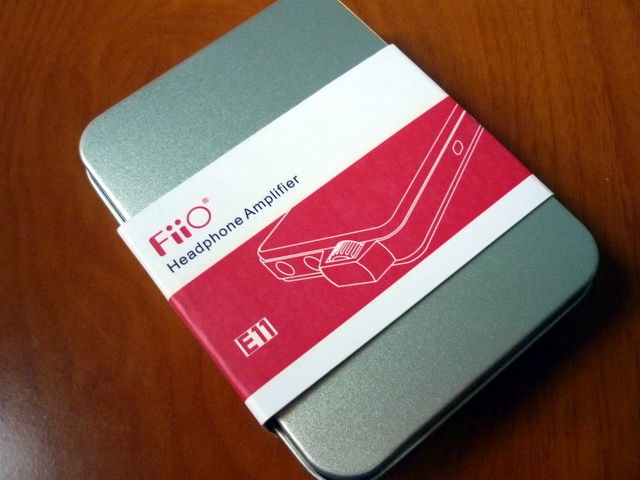
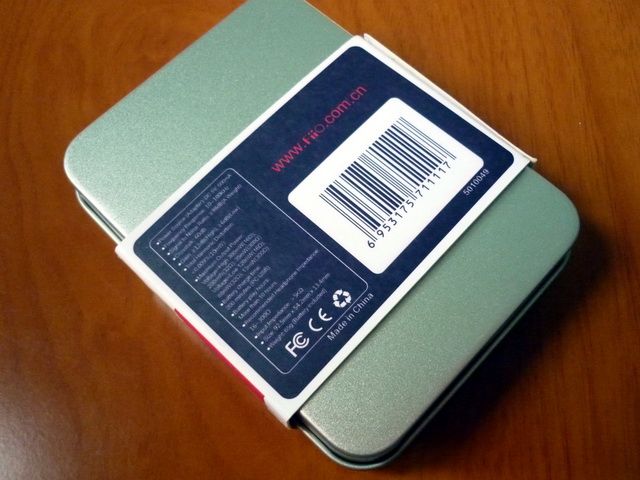
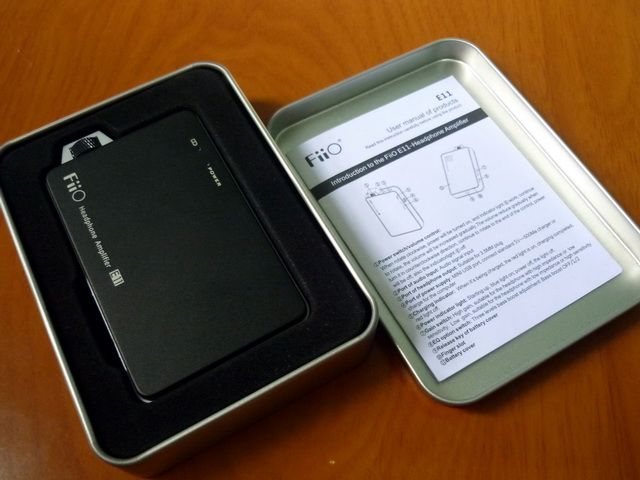
SPEC
Output Power:
High Power Mode - 300mW (16Ω); 200mW (32Ω); 35mW (300Ω)
Low Power Mode - 120mW (16Ω); 88mW (32Ω); 13mW (300Ω)
Headphone Impedance Range: 16 Ω ~ 300Ω
Input Impedance: >5kΩ
SNR: ≥98dB (A weighted)
Crosstalk: 60dB
Gain: ≥12dB (high) / ≥6dB (low)
Distortion: <0.009% (10mW)
Frequency Range: 10Hz ~ 100kHz
Size: 92.5mm x 54.2mm x 13.4mm
Weight: 65g (battery included)
Recharging: USB 5V DC 500mA
Recharging Time: 200 minutes (PC USB port)
Battery Life: more than 10 hours
Battery Replacement: Nokia BL-5B Compatible (3.7v, ≥800mAh)
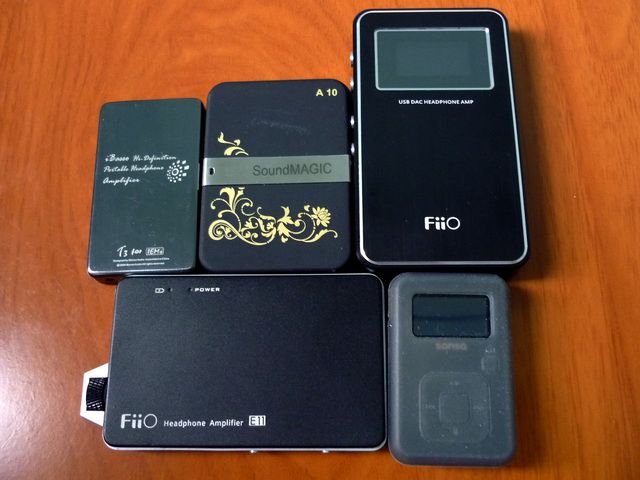
Size comparison: iBasso T3D, SoundMAGIC A10, FiiO E7, FiiO E11 and Sandisk Sansa Clip+
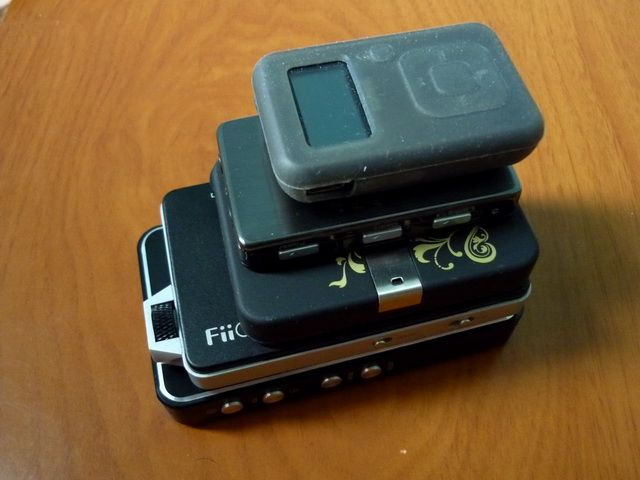
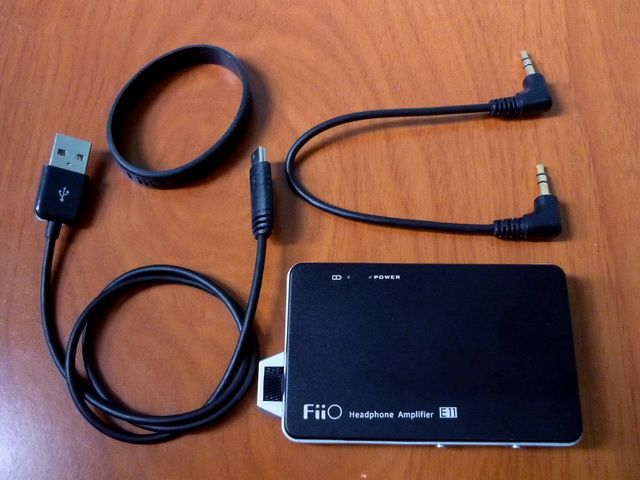
Build Quality and Accessories
Well, it is FiiO and so you can expect the E11 to be very decently built. Of course this is not to say that it can compare with the finish of a RSA or Headamp portable amp. Then again, E11 build quality is already a class above any DIY product in the same price range. The main body is fully plastic, which is understandable since it is not practical to make a metal frame of such a complex inner design. The only thing to complain is perhaps the silvery paint on the plastic body. It does come off when scratched hard enough, but that’s really a minor issue. The black panels on both sides seem to be anodized aluminum to help to reduce electro-magnetic interference. The volume knob serves also as the On/Off switch and it is protected by a ‘ridge’ so accidental volume change is pretty much minimum even inside a tight pant. On the other side of the case is a small button to open one of the side panels to access the battery bay and the power mode switch. The power mode switch is actually quite small so a pointy tool is needed to flip it if you have fat fingers like mine.
Accessories wise, there is a USB cable for recharging, a decent mini-to-mini interconnecting cable and a silicone band for holding the amp and DAP together.
Before we go any further, here is some hardware info regarding E11. The main opamp is AD8397, which is used on amps like Mini^3 as well as Arrow 12HE and well known for its high current output. The virtual ground is driven by a similar combo found on Mini^3, the TLE2426 + OPA690. But that is where the similarities end. As I was told, the voltage is about +/-6V or +/-9V (depend on which power mode is selected) using FiiO’s own design. I am not an electronic engineer so I won’t attend to lecture anyone on the detail.
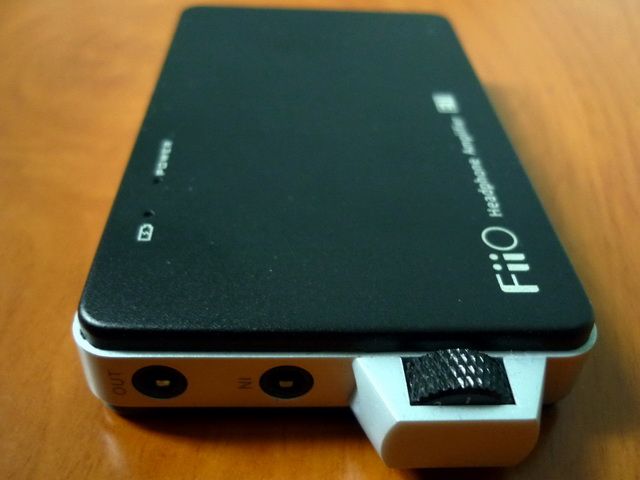

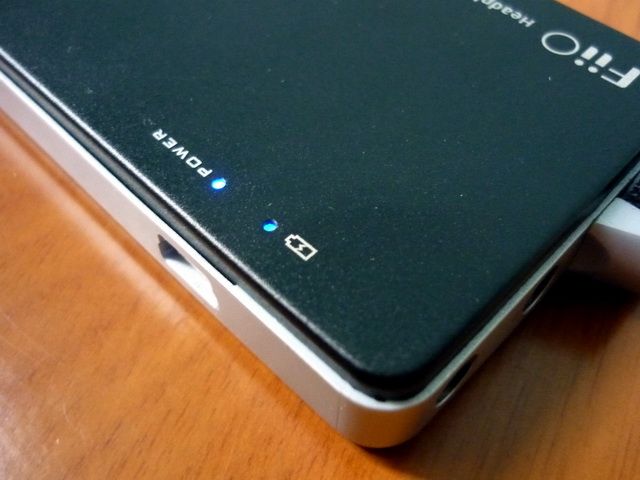
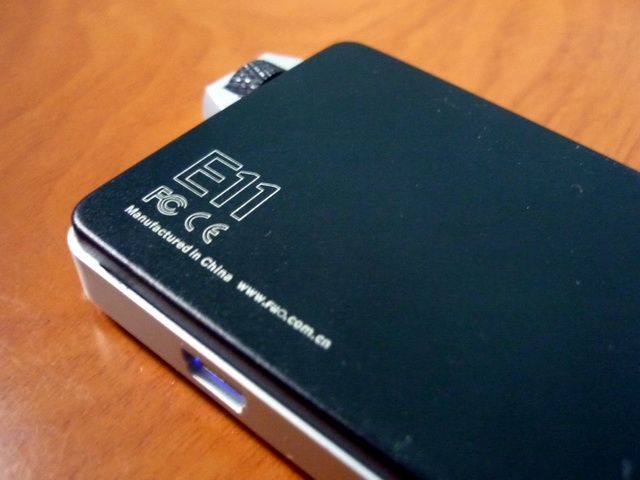
Battery Life
The BL-5B battery is originally meant for cellphone and the one FiiO used is quoted at 800mAh. It has an internal protection circuit that prevents overcharging up to 4.2V as well as overdrawing to as low as 3V (some other brands can go as low as 2.7V).
Battery life is tested in two configurations: First, E11 was set to low power mode, low gain, no bass boost. Second, E11 was set to high power mode, high gain, Lv2 bass boost. Volume varied around 3 to 3.5 / 9 on the volume pot on a 32 ohm dynamic IEM. The actual volume is what I will consider to be ‘enjoyable in 5 minutes, but unsafe for any time longer’ - yes, it is pretty loud.
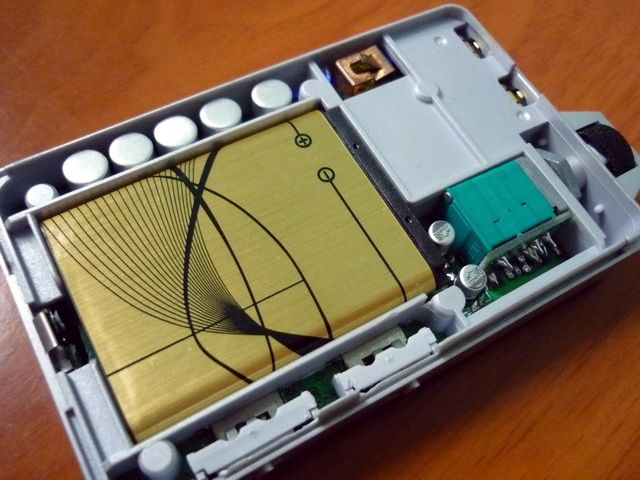
In first configuration, I stopped the test at around 18hrs or so and the battery was measured to be 3.6V or so, indicating that the E11 can easily run for over 20hrs if I decided to continue. In second configuration, I stopped the test at around 12hrs or so and the battery was measured to be 3.2V and could probably run for a few hours more. Later, I reran the test in the second configuration at slightly high volume (close to 4/9) for full battery drain and it lasted about 14~15 hours in total and the battery cut itself off at 3V. So the basic conclusion is that E11 should easily surpass the quoted 10 hrs battery runtime in most situations. During all the tests, no problem is detected on recharging the li-ion battery.
A little bit of li-ion battery 101 (this applies to any device with similar li-ion battery): One thing to note is never to fully drain li-ion battery for any purpose. The proper technique to care for li-ion battery is to recharge it as often as you can in order to prolong the battery life. If you are not going to use a li-ion battery in a long time, you can let it drain to about 70%, then store it at a cold and dry place. Or else, you should change it at least once every month. If the voltage falls under 2.7V for whatever reasons (i.e. fast overdraining, overly prolonged storage), the protection circuit might stop you from recharging the battery. If that happens, you will need to reset the battery and force charge it (= let it sits in the charger for a while). If the voltage already dropped too low, the battery will lose it capacity and a new BL-5B will be needed.

Power mode switch is underneath the battery.
Note that it takes about 3 hours to fully charge an empty battery and you can’t use it when recharging. The charging circuit and the virtual ground don’t like each other so FiiO put a protection circuit to isolate them from each other. An inconvenience? Yes, but an extra BL-5B with charger isn’t that expensive or difficult to find.
Extra note: I ordered an extra battery for testing but it has not arrived yet. The result will be added when I received and have the chance to play with it.
[UPDATE May 21st.] The claimed 2050mAh BL-5B battery (from this eBay store) came yesterday and I reran the battery test in 2nd configuration (see above for detail). I don't have high hope for it at first but I reckon I should at least be able to par the stock battery at worst. Surprisingly the battery works out really well. I measured 3.64V after 12hrs, which is about the same as low power mode in 1st configuration. A simple linear estimation puts another 12hrs battery life left in the battery, making it a total of 24hrs from a single charge. To add to the plus side, I didn't pre-condition the battery when I received it, so this is the first charge and it should only get better once I recharge it several times. Of course battery generally doesn't drop in linear fashion as estimated but I think 18~20 hrs or so should be easily achievable. Now this so far isn't really a real 2050mAh yet if we compared the result with the stock 800mAh battery. If it was 2050mAh, we would have got 37hrs instead, not 24hrs - then again, I haven't conditioned the battery. Regardless, this is still a pretty decent investment for the extended battery life, especially consider a genuine Nokia BL-5B 760mAh can go for $10+ a piece from reputable seller. The listed eBay price is $16 and only to U.S. with free shipping. But if you asked the seller, he can send it to most of the world with $2 of registered mail with tracking.
Hissing
Yes, E11 does hiss a little, but mainly limits to a few low impedance, highly sensitive and hiss-prone IEM like the Shure SE530 (and I expect SE535 to behave similarly) and Westone UM2. Unlike FiiO’s E5 and E7 which use gain-controlled-volume, the E11 has two fixed gain settings. This means the hiss level doesn’t change much with volume. The major contributor of hiss seems to be the bass boost circuit. Turning on the bass boost will increase the hiss. But at worst on no bass boost, it is only audible when no music is playing or between a quiet passage. Of course this is not unique to E11 as I can also hear almost the same level of hiss on T3D with SE530 on high gain. For most IEM though, the hissing is either inaudible or very close to being inaudible unless in absolute quiet.
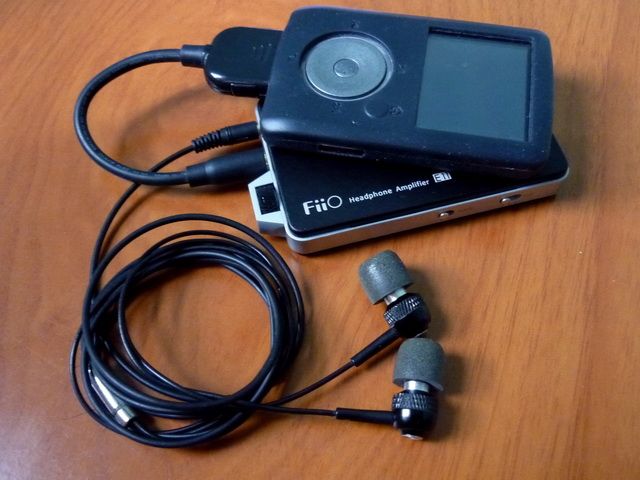
Sound Quality and EQ
Compare to its elder brother the E7, E11 retains the same type of sound signature. It is clean and transparent. While E7 can be a little too dry and cold which makes it sounds a little grainy on the top, not the best with analytical sounding headphone. The E11 is just a tad warmer not to fall into the same trap but at the same time not appear to be obviously colored. E11 also has a better bass boost implementation. Most of the boosting (see graph below) is done in the sub-bass region and it won’t affect the rest of the frequency response. It adds a lot of kick and deep rumble without feeling sloppy or boomy. It output power is as expected, a lot more powerful than E7 and can handle much higher input signal without clipping like the E7.
How about E11 compares to amps of similar price, say SoundMAGIC A10 and JDS Lab’s cmoyBB v2.02? A10 vs. E11 remind me a little of iBasso T4 vs. T3D. A10 is more toward warm and musical, which is quite contrast to E11 cleaner and colder sound. Technically E11 sounds just a little more resolving and detail, but A10 bigger and more textured bass is also hard to dispute with a cold sounding IEM like Etymotic ER4S or to a lesser degree, the HifiMan RE0. The stock OPA2227 based JDS cmoyBB sound signature is in between E11 and A10, but more toward A10’s musicality while retains a very decent level of transparency – just not quite as transparent as E11. It is a sound I can’t fault but at the same time, lacks just the resolution I find to love on E11. The really interesting bit is that cmoyBB opamp can be rolled – and I think cmoyBB can be very a strong competition to E11 if you are willing to put an AD8620 on it. If you asked me, I’ll say all three of them are very good buy on their price point. E11 has its technical ability, A10 has its musicality and cmoyBB has a little bit of both. Of course neither A10 nor cmoyBB can output nearly as much power as E11 when it comes to very difficult to drive headphone. I doubt any sub-$100 portable amp has that much power anyway.
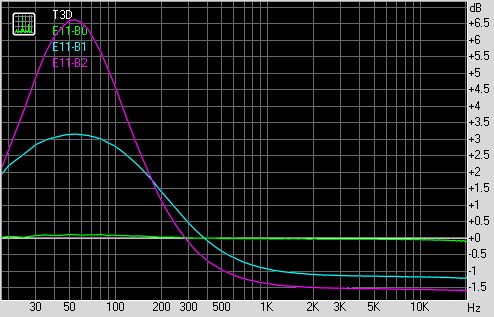
A simple RMAA test is performed using T3D as reference. E11 is on various bass boost levels.
The real comparison for E11 is iBasso T3D. They share largely the same sound signature, clean, detailed and transparent. T3D has a darker background while E11 is more dynamic and throw out a slightly better image and soundstage. Overall, E11 sounds just a tad more effortless and more open, especially when it comes to slightly demanding earphone like ER4S, RE262 and PK1. Do I prefer E11 over T3D? Yes. Do I think E11 totally trash T3D? No. E11 is edging out on T3D but they are still very much on the same level performance wise. They can both drive my 150ohm IEM and earbuds with ease, but I would imagine E11 might trump T3D when it comes to hard-to-drive big cans. Then again, T3D isn’t really designed to be used with big cans.
I tried a few full sized headphones such as Grado SR325i and Fischer Audio FA-003 with E11 and I find them sounding as good as ever. However, neither of them really needs much amping anyway. Without any full sized that is really hard to drive, there isn’t much I can show you. However, I hardly pass 3.5/9 on the volume pot in high gain / high power mode in all of my testing and there is still a lot more power in E11 that I will likely never been able to use. Some words of caution here: be careful on how fast you turn the volume on E11 as I almost blew my eardrum out when I accidentally turned it too high once.
Synergy wise, E11 sounded just as good with almost any headphones I tried because of its transparency. It is not a very picky amp when it come to pairing. Of course you can expect a lean and cold sounding IEM like the ER4S getting a better result with cmoyBB or A10 synergy wise, but this is not to say E11 will make ER4S sounds bad in anyway. If anything I find E11 to be a very versatile amp when it comes to pairing with different sounding headphone.
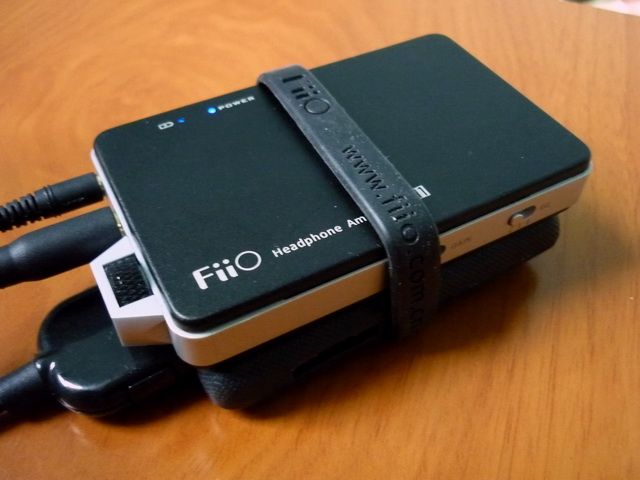
Verdict
For $60 or so, E11 is an absolutely fantastic portable amp that can easily match up with many amps that doubles its price. If FiiO is known for making big bang for the bucks’ product, I reckon E11 must be close to being atomic level. Portable amp has never been a truly mass produced products before FiiO comes to the market, yet their monthly production rate currently can easily surpass the yearly quantity of several of other portable amp makers combined. While FiiO might not make the best sounding or looking portable amp in the world, I doubt anyone can dispute the sheer number of users that have been drew by FiiO to this little audiophile hobby of ours. If you were to ask me what really is the game changer in the portable world, I will tell you it is affordable products like the E11 that truly turn the market around, not the expensive stuff.





